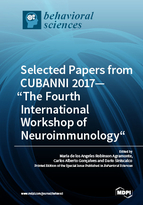Selected Papers from CUBANNI 2017—“The Fourth International Workshop of Neuroimmunology”
A special issue of Behavioral Sciences (ISSN 2076-328X).
Deadline for manuscript submissions: closed (31 March 2018) | Viewed by 81333
Special Issue Editors
Interests: neuroimmunology; neurodegenerations; demyelinating diseases; Multiple Sclerosis; COVID-19 pandemic; HcoV; SARS-CoV-2; virus neuroinvasion; stem cells; neuroinflammation; neurodevelopment disorders
Special Issues, Collections and Topics in MDPI journals
Interests: astrocyte; Alzheimer; calcium-binding proteins; neuroprotection
Special Issues, Collections and Topics in MDPI journals
Special Issue Information
Dear Colleagues,
The Organizing Committee of CUBANNI 2017, the First International Meeting of the Cuban Network of Neuroimmunology, invite delegates presenting papers selected for this meeting to publish in the Special Issue of CUBANNI 2017—“Fourth International Workshop of Neuroimmunology”. This Special Issue aims to resume the main topics of papers that were presented, selected by their relevance, quality, and impact in the field of Neuroimmunology and Neuroscience research. Topics included in the symposia are in the program of the Fourth International Workshop of Neuroimmunology, in parallel with the VIII International Symposium of Hereditary Ataxias and other neurodegenerations, the First Workshop on Epigenetics, biomarkers and interventions in demyelinating diseases, and the Symposium on Current Tools on Neurointervention and Technologies in Neuroimmunology and Neuroscience, involving topics such as neuroimmunology, neuroinflamation, glial reaction, biomarkers, stem cell therapy, neurodegenerative and neurodevelopmental disorders, psychoneuroimmunology, the blood brain barrier, Cerebrospinal fluid analysis and lymphocyte trafficking in Central Nervous System. Clinical and basic research arguing the immunological mechanisms underlying brain damage and neuroplasticity in neurological disorders such as autism, multiple sclerosis and NMO, ataxias, stroke, Huntington disease, CNS infections, aging and age related neurological disorders are relevant topics to be proposed.
Prof. Dr. Maria Robinson-Agramonte
Prof. Dr. Dario Siniscalco
Prof. Dr. Carlos Alberto Gonçalves
Guest Editors
Manuscript Submission Information
Manuscripts should be submitted online at www.mdpi.com by registering and logging in to this website. Once you are registered, click here to go to the submission form. Manuscripts can be submitted until the deadline. All submissions that pass pre-check are peer-reviewed. Accepted papers will be published continuously in the journal (as soon as accepted) and will be listed together on the special issue website. Research articles, review articles as well as short communications are invited. For planned papers, a title and short abstract (about 100 words) can be sent to the Editorial Office for announcement on this website.
Submitted manuscripts should not have been published previously, nor be under consideration for publication elsewhere (except conference proceedings papers). All manuscripts are thoroughly refereed through a single-blind peer-review process. A guide for authors and other relevant information for submission of manuscripts is available on the Instructions for Authors page. Behavioral Sciences is an international peer-reviewed open access monthly journal published by MDPI.
Please visit the Instructions for Authors page before submitting a manuscript. The Article Processing Charge (APC) for publication in this open access journal is 2200 CHF (Swiss Francs). Submitted papers should be well formatted and use good English. Authors may use MDPI's English editing service prior to publication or during author revisions.
Keywords
- neuroimmunology
- neuroinflammation
- epigenetic and gene expression
- molecular biomarkers
- neuroinmunomodulation
- stem cell therapy
- microRNA
- neural plasticity









